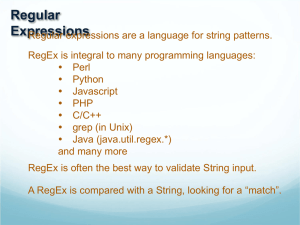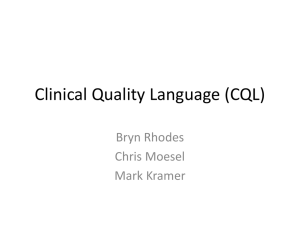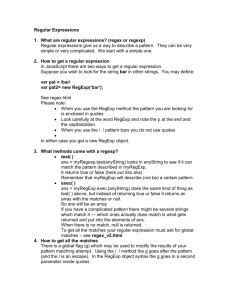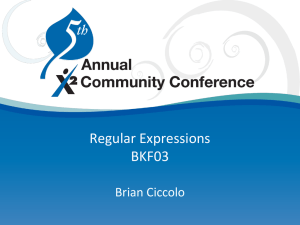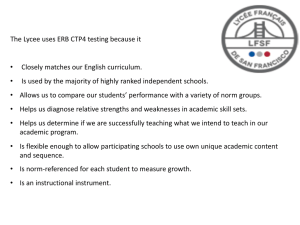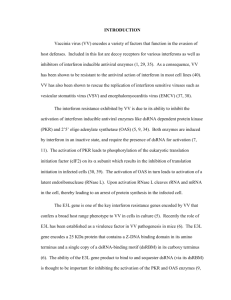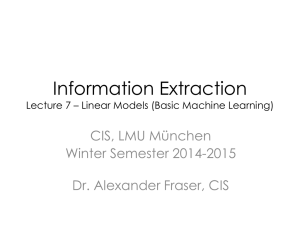lin3098-regex
advertisement
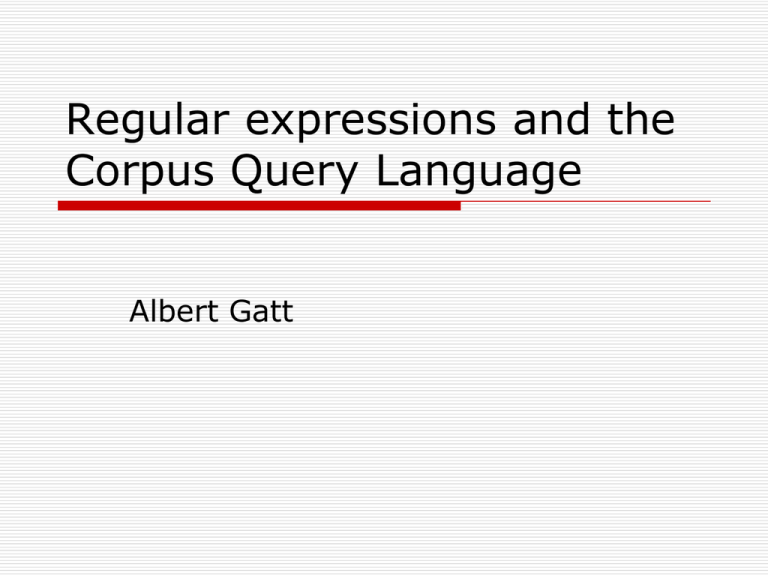
Regular expressions and the
Corpus Query Language
Albert Gatt
Corpus search
These notes introduce some practical
tools to find patterns:
regular expressions
the corpus query language (CQL):
developed by the Corpora and Lexicons
Group, University of Stuttgart
a language for building complex queries
using:
regular expressions
attributes and values
A typographical note
In the following, regular expressions
are written between forward slashes
(/.../) to distinguish them from
normal text.
You do not typically need to enclose
them in slashes when using them.
Practice
Log in to the sketchengine
http://the.sketchengine.co.uk
Choose the BNC
Practice
In the concordance window, click
Query type
Practice
Then choose Phrase as your query
type
Practice
In what follows, we’ll be trying out
some pattern searches.
This will help you grasp the idea of
regular expressions better.
Part 1
REGULAR EXPRESSIONS
Regular expressions
A regular expression is a pattern that
matches some sequence in a text. It
is a mixture of:
characters or strings of text
special characters
groups or ranges
e.g. “match a string starting with the
letter S and ending in ane”
The simplest regex
The simplest regex is simply a string
which specifies exactly which tokens
or phrases you want.
These are all regexes:
the tall dark lady
dog
the
Beyond that
But the whole point if regexes is that
we can make much more general
searches, specifying patterns.
Delimiting regexes
Special characters for start and end:
/^man/ => any sequence which begins
with “man”: man, manned, manning...
/man$/ => any sequence ending with
“man”: doberman, policeman...
/^man$/=> any sequence consisting of
“man” only
Groups of characters and choices
/[wh]ood/
matches wood or hood
[…] signifies a choice of characters
/[^wh]ood/
matches mood, food, but not wood or
hood
/[^…]/ signifies any character except
what’s in the brackets
Practice
Type a regular expression to match:
The word beginning with l or m followed
by aid
This should match maid or laid
[lm]aid
The word beginning with r or s or b or t
followed by at
This should match rat, bat, tat or sat
[rbst]at
Ranges
Some sets of characters can be
expressed as ranges:
/[a-z]/
any alphabetic, lower-case character
/[0-9]/
any digit between 0 and 9
/[a-zA-Z]/
any alphabetic, upper- or lower-case
character
Practice
Type a regular expression to match:
a date between 1800 and 1899
18[0-9][0-9]
the number 2 followed by x or y
2[xy]
A four-word letter beginning with i in
lowercase
i[a-z][a-z][a-z]
Disjunction and wildcards
/ba./
matches bat, bad, …
/./ means “any single alphanumeric
character”
/gupp(y|ies)/
guppy OR guppies
/(x|y)/ means “either X or Y”
important to use parentheses!
Practice
Rewrite this regex using the (.)
wildcard
A four-word letter beginning with i in
lowercase
i[a-z][a-z][a-z]
i...
Does it match exactly the same
things?
Why?
Quantifiers (I)
/colou?r/
matches color or colour
/govern(ment)?/
matches govern or government
/?/ means zero or one of the
preceding character or group
Practice
Write a regex to match:
color or colour
colou?r
sand or sandy
sandy?
Quantifiers (II)
/ba+/
matches ba, baa, baaa…
/(inkiss )+/
matches inkiss, inkiss inkiss
(note the whitespace in the regex)
/+/ means “one or more of the
preceding character or group”
Practice
Write a regex to match:
A word starting with ba followed by one
or more of characters.
ba.+
Quantifiers (III)
/ba*/
matches b, ba, baa, baaa
/*/ means “zero or more of the preceding
character or group”
/(ba ){1,3}/
matches ba, ba ba or ba ba ba
{n, m} means “between n and m of the
preceding character or group”
/(ba ){2}/
matches ba ba
{n} means “exactly n of the preceding character
or group”
Practice
Write a regex to match:
A word starting with ba followed by one or
more of characters.
ba.+
Now rewrite this to match ba followed by
exactly one character.
ba.{1}
Re-write, to match b followed by between two
and four a’s (e.g. Baa, baaa etc)
ba{2,4}
Part 2
THE CORPUS QUERY
LANGUAGE
Switch the sketchengine
interface
Under Query type, select CQL
CQL syntax
So far, we’ve used regexes to match strings
(words, phrases).
We often want to combine searches for
words and grammatical patterns.
CQL queries consist of regular expressions.
But we can specify patterns of words,
lemmas and tags.
Structure of a CQL query
[attribute=“regex”]
What we want to
search for. Can be
word, lemma or tag
The actual pattern it
should match.
Structure of a CQL query
Examples:
[word=“it.+”]
Matches a single word, beginning with it
followed by one or more characters
[tag=“V.*”]
Matches any word that is tagged with a
label beginning with “V” (so any verb)
[lemma=“man.+”]
Matches all tokens that belong to a lemma
that begins with “man”
Structure of a CQL query
[attribute=“regex”]
What we want to
search for. Can be
word, lemma or tag
The actual pattern it
should match.
Each expression in square brackets matches one word.
We can have multiple expressions in square brackets to match a
sequence.
CQL Syntax (I)
Regex over word:
[word=“it”] [word=“resulted”] [word=“that”]
matches only it resulted that
Regex over word with special characters:
[word=“it”] [word=“result.*”] [word=“that”]
matches it resulted/results that
Regex over lemma:
[word=“it”] [lemma=“result”] [word=“that”]
matches any form of result (regex over lemma)
Practice
Write a CQL query to match:
Any word beginning with lad
[word=“lad.*”]
The word strong followed by any noun
NB: remember that noun tags start with
“N”
[word=“strong”] [tag=“N.+”]
CQL Syntax II
We can combine word, lemma and
tag queries for any single word.
Word and tag constraints:
[word=“it”] [lemma=“result” & tag=“V.*]
Matches only it followed by a morphological
variant of the lemma result whose tag
begins with V (i.e. a verb)
Practice
The word strong followed by any
noun
[word=“strong”] [tag=“N.+”]
Rewrite this to search for the lemma strong
tagged as adjective
NB: Adjective tags in the BNC start with AJ
[lemma=“strong” & tag=“AJ.*”][tag=“N.+”]
The lemma eat in its verb (V) forms
[lemma=“eat” & tag=“V.*”]
CQL syntax III
The empty square brackets signify
“any match”
Using complex quantifiers to match
things over a span:
[word=“confus.*” & tag=“V.*”] []{0,2} [word=“by”]
“verb beginning with confus tagged as verb, followed by
the word by, with between zero and two intervening words”
confused by (the problem)
confused John by (saying that)
confused John Smith by (saying that)
Practice
Search for the verb knock (in any of
its forms), followed by the noun door,
with between zero and three
intervening words:
[lemma=“knock” & tag=“V.*”][]{0,3}[word=“door” & tag=“N.*”]
We can count occurrences of
these complex phrases
Node forms = the actual
phrases
Node tags = the tag sequences
CQL summary
A very powerful query language
BNC SARA client uses CQL
online SketchEngine uses it too
Ideal for finding complex grammatical
patterns.
A final task
Choose two adjectives which are
semantically similar.
Search for them in the corpus,
looking for occurrences where they’re
followed by a noun.
Run a frequency query on the results.


